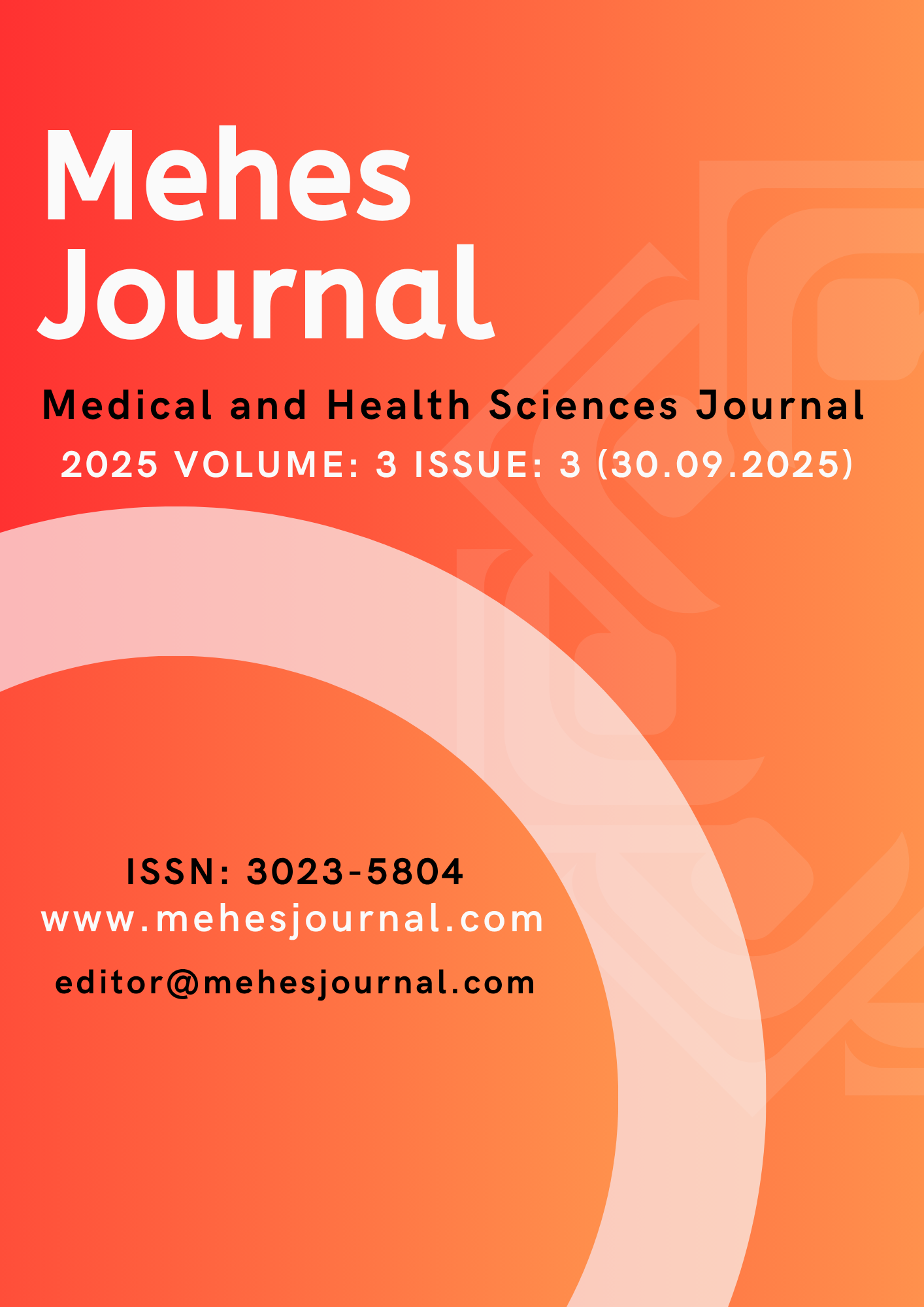Ameliyathanedeki Sağlık Profesyonellerinin Cerrahi El Yıkama Prosedürleri: Aseptik Ellerin Gücü
DOI:
https://doi.org/10.5281/zenodo.17238209Anahtar Kelimeler:
Cerrahi, el yıkama, cerrahi ovalama, ameliyathanelerÖzet
Hastane enfeksiyonları, hastanede yatış süresini uzatan, morbidite ve mortaliteyi artıran, ayrıca tedavi maliyetlerini yükselten önemli bir sağlık sorunu olarak öne çıkmaktadır. Bu enfeksiyonların yayılmasında, özellikle sağlık profesyonellerinin elleri, mikroorganizmaların hastaya geçişinde kritik bir rol oynamaktadır.Yüksek morbidite, mortalite ve tedavi maliyetleri ile sonuçlanan bu enfeksiyonlardan korunmanın en etkili yöntemlerinden biri, yeterli ve doğru el hijyeninin sağlanmasıdır. Çağdaş sağlık hizmetleri anlayışı, sağlığın korunması ve geliştirilmesine odaklanmakta olup, bu çerçevede her bireyin kişisel hijyen kurallarına uyması, sağlığının korunması açısından büyük bir öneme sahiptir. El yıkama, hastane enfeksiyonlarını önlemenin ve oranlarını azaltmanın en etkili, basit ve maliyet açısından en uygun yolu olarak kabul edilmektedir. Özellikle ameliyathanelerde hastane enfeksiyonlarının başında gelen cerrahi alan enfeksiyonu olgularını önlemek için uygun bir cerrahi el yıkama prosedürünün sürdürülmesi gerekmektedir. Ameliyathanede çalışan sağlık profesyonellerinin, el temizliğini doğru bir şekilde ve yeterince uygulaması hem meslek risklerinin azaltılmasına hem de hastane enfeksiyonlarının etkin bir şekilde kontrol altına alınmasına önemli bir katkı sağlamaktadır.
Referanslar
Pittet D. Improving adherence to hand hygiene practice: a multidisciplinary approach. Emerg Infect Dis. 2001;7(2):234–40.
World Health Organization. WHO guidelines on hand hygiene in health care. Geneva: WHO; 2009. https://www.who.int/publications/i/item/9789241597906
Anvika R. Current prevalence and cost analysis of surgical site infections in hospital settings. J Clin Hosp Epidemiol. 2024;18(1):45–52.
Allegranzi B, Pittet D. Role of hand hygiene in healthcare associated infection prevention. J Hosp Infect. 2009;73(4):305–15.
Boyce JM, Pittet D. Guideline for hand hygiene in health care settings: recommendations of the Healthcare Infection Control Practices Advisory Committee and the World Health Organization. MMWR Recomm Rep. 2002;51(RR-16):1–44.
Tanner J, Dumville JC, Norman G, Fortnam M. Surgical hand antisepsis to reduce surgical site infection. Cochrane Database Syst Rev. 2016;(1):CD004288.
Bouslimani A, da Silva R, Wang M. The human skin microbiome: the importance of the hand flora. Nat Rev Microbiol. 2019;17(3):145–55.
Kramer A, Schwebke I, Kampf G. How long do nosocomial pathogens persist on inanimate surfaces. A systematic review. BMC Infect Dis. 2006;6(1):130.
Larson EL. APIC guidelines for handwashing and hand antisepsis in health care settings. Am J Infect Control. 1995;23(4):251–69.
Relman DA. The human microbiome: ecosystem resilience and health. Nutr Rev. 2012;70(Suppl 1):S2–9.
Weber DJ, Anderson DJ, Sexton DJ, Rutala WA. Role of the environment in the transmission of Clostridium difficile infection in healthcare settings. Infect Control Hosp Epidemiol. 2013;34(5):409–16.
Aslaner H, Akinci E, But A, Kanyilmaz D, Bastug A, Aypak A. Evaluation of surgical site infections detected in a tertiary hospital. Turkish Bulletin of Hygiene and Experimental Biology. 2018;75(3).
World Health Organization. Global guidelines for the prevention of surgical site infection. Geneva: World Health Organization; 2016. https://www.who.int/publications/i/item/9789241550475
Kampf G, Loffler H. Hand disinfection in hospitals: benefits and risks. J Dtsch Dermatol Ges. 2010;8(12):978–83.
Centers for Disease Control and Prevention. Know how to wash hands with soap and water. Atlanta: CDC; 2024. https://www.cdc.gov/handwashing/when-how-handwashing.html
Republic of Turkey Ministry of Health. Handwashing and hand disinfection guide for healthcare personnel. Ankara: Republic of Turkey Ministry of Health; 2008. https://hsgm.saglik.gov.tr/depo/birimler/saglikli-beslenme-ve-hareketli-hayat-db/Dokumanlar/Kitaplar/Saglik_Personeline_Yonelik_El_Yikama_ve_El_Dezenfeksiyonu_Rehberi.pdf
Tan G. Perioperative surgical handwashing practice and solutions used. In: 7. Proceedings Book of the National Sterilization Disinfection Congress; 2011. p. 147–61.
Association of periOperative Registered Nurses. Guidelines for perioperative practice. Denver: AORN; 2020. https://www.aorn.org/guidelines-resources/guidelines-for-perioperative-practice
General Directorate of Public Health. Handwashing and hand disinfection guide for healthcare personnel. Ankara: Republic of Turkey Ministry of Health; 2018. https://hsgm.saglik.gov.tr/depo/birimler/saglikli-beslenme-ve-hareketli-hayat-db/Dokumanlar/Beslenme/Saglik-Personeline-Yonelik-El-Yikama-ve-El-Dezenfeksiyonu-Rehberi.pdf
Nthumba PM, Stepita-Poenaru E, Poenaru D, Bird P, Machoki M, Alexander K. Efficacy of alcohol based hand rubs in surgical hand preparation. J Hosp Infect. 2010;74(2):245–7.
Iwakiri K, Moroi R, Seki M, Taira K, Matsuda T. Waterless alcohol based surgical hand antisepsis in an operating room setting. Am J Infect Control. 2017;45(9):1006–10.
Trick WE. Modifiable risk factors associated with Pseudomonas aeruginosa colonization. Infect Control Hosp Epidemiol. 2003;24(10):756–60.
Parienti JJ, Thibon P, Heller R, Legrand P, Samii K, Megarbane B. Hand rubbing with an aqueous alcohol solution vs traditional surgical hand scrubbing and 30 day surgical site infection rates: a randomized equivalence study. JAMA. 2002;288(6):722–7.
Kahraman B, Yalcin H. Comparison of initial and repeated surgical hand antisepsis practices. Turk J Infect Control. 2020;24(1):10–5.
Anderson DJ. Hand hygiene and surgical hand antisepsis. Healthcare Infect. 2014;19(2):38–43.
Hibbard JS. Analysis comparing the antimicrobial activity and safety of current antiseptic agents: a review. J Infus Nurs. 2005;28(3):194–206.
Rutala WA, Weber DJ. Selection of the ideal antiseptic agent. Infect Control Hosp Epidemiol. 2016;37(5):564–9.
Chen YH, Chen ML, Chou YC, Wang YH, Chang SC. Waterless surgical hand antisepsis using an alcohol based handrub: cost and time benefits. Am J Infect Control. 2012;40(6):e77–80.
Chen YH, Wang YH, Lin SY, Chou YC, Chou HC, Chang SC. Efficacy of two surgical hand scrub preparations in a hospital setting. J Hosp Infect. 2013;83(2):145–8.
Gul H, Aygin D. The effectiveness of alcohol based hand antiseptics in surgical hand hygiene. Turk J Hyg Exp Biol. 2021;78(2):123–30.
Aygin D, Yildiz F. Evaluation of the effectiveness of alcohol based hand rubs in surgical hand antisepsis. Nurs Res Pract. 2020;12(2):67–73.
İndir
Yayınlanmış
Nasıl Atıf Yapılır
Sayı
Bölüm
Lisans
Telif Hakkı (c) 2025 MEHES JOURNAL

Bu çalışma Creative Commons Attribution 4.0 International License ile lisanslanmıştır.










